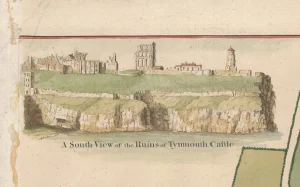Wood frame has a 3cm face width. Printed on 350g matt texture paper and shipped ready to hang.
Artwork size: 17”x7”.
Glass cover.
Bright white mount has a border of 5.7cm.
Overall Dimensions (W x H): 22″x12″
- Tax included.
- Refunds & Returns.
£24.00
This is an important pre-industrial map that depicts the Lower Tyne and North Shields on the cusp of rapid growth. The survey was one of several commissioned by Trinity House and undertaken by Newcastle mathematician, John Fryer. It records extensive soundings of the river, the navigation transits and large bodies of sand.
Sandbanks were a major problem during these times, as commerce was expanding nationally and globally and the river became increasingly chaotic. This meant accurate surveys like this became vital.
The duty of keeping the river navigable was held by the Corporation of Newcastle, who in return, received dues from ships using the port. But around this period, Trinity House as well as a coalition of shipowners and masters vigorously protested that the river was being choked up by ballast discharged from vessels.
This is described in Guthrie’s ‘The River Tyne’ (1880):
“From the time of Gardner downwards, one continued string of complaints continued to be made of the alleged shoaling and deterioration of the river.
Captain Phipps, a man of great knowledge in nautical matters, who was a candidate for the representation of the town in 1774, and who shortly afterwards became Lord Mulgrave, said he considered the River Tyne capable of becoming one of the finest rivers in the world, but ignorance, inattention, and avarice had converted it into a “cursed horse-pond.”
It was charged as a special grievance against the Corporation, that their wasteful and extravagant mode of dealing with the ballast brought into the port, and the heavy rates charged caused vessels to discharge ballast at sea in positions where it was liable to be washed on to the sands at the mouth of the river, or into the river itself; also that the ballast put on shore by the Corporation, by carelessness and want of proper precaution found its way again into the river, and that large quantities were deliberately thrown into the river by vessels.
About 1760 a Mr. Liddell had propounded a plan for taking out ships’ ballast and depositing it at sea in positions where it would not wash into the harbour. Many shipowners and captains trading to the Tyne petitioned the Corporation in favour of its adoption, which the Council, however, declined to do. Demands were made that the Conservancy should adopt some mechanical mode of cleansing the river such as was being done in the Clyde.
About the year 1802 Mr. Chapman, a civil engineer, propounded a plan for removing the Insand and Middle Ground, two of the greatest obstructions in the harbour, but the plan was not entertained by the Corporation. Few if any steps were taken with a view to improvement or bettering of the river, with the exception of the removal, about 1790, of some projecting rock and stones abreast of the Black Middens,”
It wasn’t until the Tyne Improvement Commission dredged 800 acres of sand out of the river in the 1850s, that it became an modern industrial waterway.
Urban Settlement
In this map we see the Georgian streets of Shields starting to form, based on the layout of three main roperies: Mr Stephenson’s, Mrs Parson’s and Matthew Waters Esq.. The ‘flagship development’ of Dockwray Square, catering to wealthy shipowners, is in its infancy and the Rev. Dockwray’s adjoining land is marked behind it. Up river, ‘Coble Dean’ is shown and in the middle section of the map is a delightful illustration of Tynemouth Castle with its southern wall and tower intact.

On the South Shields side, we see what remained of the Mill Dam Creek, extending to where Fowler Street is now. By this time it had become a quagmire with three crossings: a bridge at the Mill Dam, a path south of St Hilda’s Church, and the road itself. The linear town beside the river reaches to Jarrow Slake, while large Ballast Hills sit north and south of Mill Dam enclosing the town from the open ground to the coast.
Wood frame has a 3cm face width. Printed on 350g matt texture paper and shipped ready to hang.
Artwork size: 17”x7”.
Glass cover.
Bright white mount has a border of 5.7cm.
Overall Dimensions (W x H): 22″x12″
| Weight | 0.47 kg |
|---|---|
| Frame Colour | Black, Light Oak |
Reviews
There are no reviews yet.